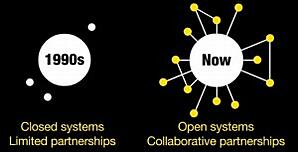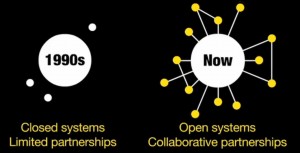A recent Demand Gen Report blog post cited a global, 1,200-person study by The Fournaise Marketing Group, which found that “80% of CEOs ‘admit they do not really trust and are not very impressed’ by their CMOs. That’s compared to the 90% of CEOs who say they do trust and value their CFOs and CIOs.”
The major discrepancy is that CFOs and CIOs are 100% ROI focused, while CMOs are “too disconnected from the financial realities of companies.”
For marketers to earn their seats at the executive table, we must become more focused on driving ROI, by achieving objectives that impact the bottom line:
- Generate leads.
- Convert leads to sales.
- Increase customer loyalty.
In my opinion, the CMO is in a position today that the CIO was in just a few years ago—working in a silo and requiring a more business-focused approach to truly make an impact on his or her organization.
But how? Platforms may be (part of) the answer.
In The Age of the Platform, Phil Simon (@philsimon) explores the platform—which he defines as “an extremely valuable and powerful ecosystem that quickly and easily scales, morphs and incorporates new features, users, customers, vendors and partners”—and its role in business innovation.

The construct and power of the platform, 1990s v. today, via Phil Simon / TheAgeOfThePlatform.com.
The book highlights Amazon, Apple, Facebook and Google (AKA the Gang of Four) as businesses that helped prove the power of platforms, and usher in the platform-centric business era. It then translates their lessons learned, encouraging business leaders to recognize the value in building platforms for their organizations.
Specifically, Simon points out that through platforms, businesses can reap great financial benefits by extending revenue streams through software licensing, affiliate programs, increased client / customer retention and more.
So why do I think that marketers make sense to lead the charge in platform integration?
Because several key factors driving successful platform development are the same as those behind the inbound marketing revolution. These are forces that marketers are innately aware of and in-tune with. Because we understand how they impact our customers, we can tap into this knowledge to help drive strategy behind the platform(s) that may be viable for our organizations.
1. When product or service capabilities, pricing and other standard purchase factors are equal, consumers will work with the vendor that provides deeper value. To achieve this, businesses need to create symbiotic relationships with multiple parties, including: partners, vendors, developers, customers and even competitors.
- Simon details how platforms can do so through planks, or platform extensions developed through collaborative builds, open APIs, helpful feature additions, and more.
- Marketing and PR are, at the core, based on building mutually beneficial relationships between an organization and its target audiences.
2. Selective consumption, or consumers’ desire and ability to engage with personalized content when, where and how they choose.
- Simon explains that good platforms answer this need innately, leveraging cloud computing and other technologies to keep customers engaged anytime and anywhere.
- This is a core driver for marketers to “go inbound,” and invest less in traditional, outbound tactics.
3. New skills are needed to develop and deliver platforms that are aligned with core business offerings, and are valuable to customers, vendors, partners and other targets.
- From the book: “Powerful platforms are not based on doing only one thing.” Rather, businesses need to extend platform capabilities (or make it possible for others to do so), add new planks and innovate to stay relevant, and keep ahead of the competition.
- Savvy marketers have been honing and expanding their skills for years, building hybrid capabilities and advancing their teams’ knowledge base in tech, mobile, social media and more.
4. The playing field has been leveled. “Long gone are the days in which large companies can effectively buy market share by spending their competition into the ground. In the Age of the Platform, word of mouth is king.”
- Inbound marketers, sound familiar?
The real kicker though—where marketers truly find their place to shine—comes in when Simon admits that simply having a great platform isn’t enough. The most successful platform-based businesses (think Gang of Four) succeed because they have a strong foundation in four key areas: company, brand, community and platform.
Marketing owns two of those four elements (brand and community). And, with business savvy and an understanding of tech as it ties to your organization, astute marketers should be able to hold their own in the company and platform conversations.
We are in a unique position to provide valuable insight and strategic guidance to help our businesses plan, develop, execute and capitalize on platforms. How’s that for a focus on real business results and ROI?
Have you read The Age of the Platform? What do you think about marketing’s role in this area of business? The comments are yours for discussion.
Stay updated: Subscribe to the PR 20/20 blog, check us out on Facebook or follow the team on Twitter.
%20Logo_BlueOrange_Trademark.png?width=800&height=269&name=Ready%20North%20(RN)%20Logo_BlueOrange_Trademark.png)




.jpg?width=300&name=Services%20Hub%203%20(3).jpg)


COMMENTS